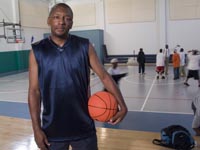Youth, Race, and Anger
June 24, 2009 - Understanding how the three mix can lead to better coping strategies
Professor Howard Stevenson is studying a videotape of a high school basketball game. Somewhere in the whirl of play is what educators call a "teachable moment." Blink and you'll miss it. There, on the edge of the screen, the point guard dribbles, pauses — and fires the ball straight at the back of one of his teammates.
 An accident? An act of aggression? When you're a young African-American male, Stevenson contends, the world is quick to label you and your actions in sinister terms. Whether you're legitimately angry, horsing around, or minding your own business, you're far likelier than your white peers to be seen as "criminal or problematic."
An accident? An act of aggression? When you're a young African-American male, Stevenson contends, the world is quick to label you and your actions in sinister terms. Whether you're legitimately angry, horsing around, or minding your own business, you're far likelier than your white peers to be seen as "criminal or problematic."
A long-time faculty member at Penn GSE and chair of its Applied Psychology and Human Development division, Stevenson has focused much of his research on making sense of moments like these and working on coping strategies with minority youth — especially boys. With funding from the National Institute of Mental Health and the W.T. Grant Foundation, he developed an anger management program for African-American adolescent males. Called PLAAY (Preventing Long-term Anger and Aggression in Youth), the program uses basketball, martial arts, and group counseling as the media of research and intervention and highlights the importance of parental support.
In its five years of operation, the PLAAY Project yielded a dramatic decline in aggressive behavior among its "high-risk" participants — all of the boys in the program had committed disciplinary infractions in school, ranging from carrying a penknife violent assault on a fellow student.
Sports — in this case, basketball — offers a setting in which conflicts arise naturally and can be addressed in the moment. "In therapy, you can tell me how you got angry," Stevenson explains, "and I can give you feedback about what to try next time. But if I'm there, I can suggest to you, 'He wasn't really trying to get at you. He bumped you. He was just playing harder.' Or, 'You're absolutely right. He was really trying to humiliate you. So here are some ways of dealing with your feelings about being humiliated.'"
To illustrate, Stevenson runs through the video clip a second time to show why the point guard flung the ball. "This kid is motivated. He's responding to the coach like every teacher wants a kid to do in a classroom. He makes a great pass and the guy misses it, and now he's pissed, because he can't get his game on.... Now you may say, 'Hey, it's just a game.' But when you're a kid, it's your life on the line."
Stevenson, acting as coach, sidelined the player. "This kid took his punishment. We gave him a talking to. He has the ability as a player to get the other team members involved. Part of our feedback to him was, 'You got to pull everyone together.'" As a result, the same student rallied the team in the second half, and they came back from trailing by 14 points to tie the game.
In Stevenson's view, fighting is scary to most boys: "When an adult comes into the middle of it and relieves them of the burden of having to prove their manhood, you can almost hear them saying to themselves, 'Thank you, Jesus! Man, I mean, I would kick your butt, but I'm so glad Dr. Stevenson was there, so I don't have to do that!'"
Because physical fights can result in severe injuries, PLAAY incorporates a "Martial Arts for Anger Reduction" component. Other components are CPR (Cultural Pride Reinforcement), which helps instill a sense of cultural pride and raise awareness of the impact of racism, and COPE (Community Outreach through Parent Empowerment), a support group for parents of boys with a history of aggression.
Learn more about Stevenson's intervention strategies and research findings in his book Playing with Anger.
